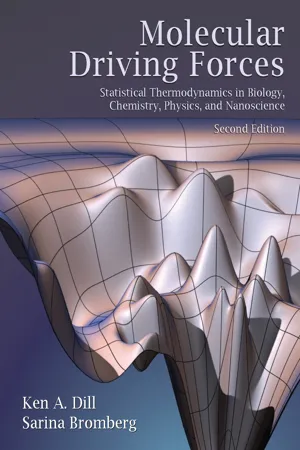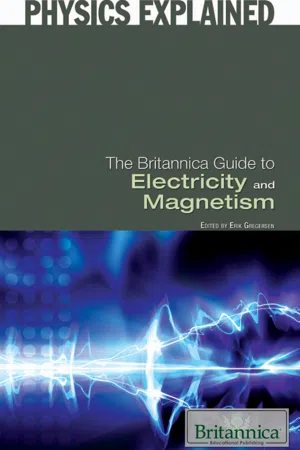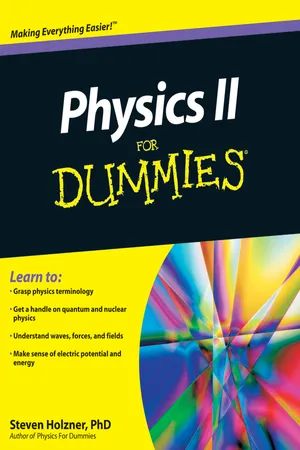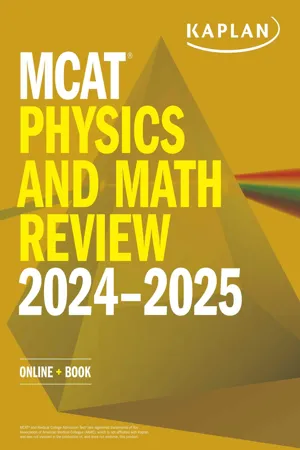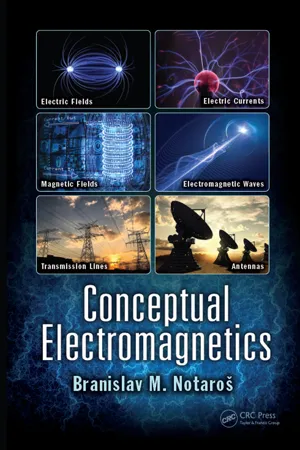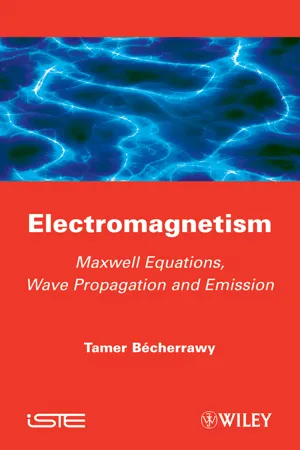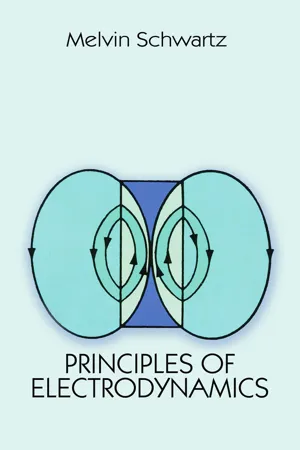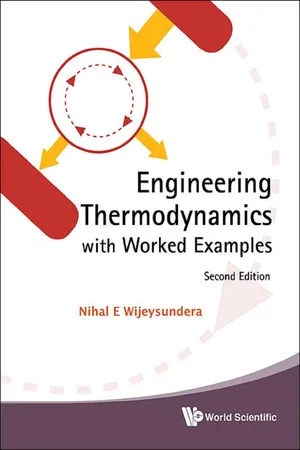Physics
Work in Electrostatics
Work in electrostatics involves the study of stationary electric charges and the forces between them. It explores concepts such as electric fields, potential energy, and the behavior of conductors and insulators in the presence of electric charges. Understanding electrostatics is crucial for various applications, including the design of electronic devices and the development of technologies such as capacitors and electrostatic precipitators.
Written by Perlego with AI-assistance
Related key terms
Related key terms
1 of 4
Related key terms
1 of 3
10 Key excerpts on "Work in Electrostatics"
- Nima Gharib, Javad Farrokhi Derakhshandeh, Peter Radziszewski(Authors)
- 2022(Publication Date)
- Elsevier(Publisher)
….- That is, the potential at each place is the total of the individual potentials attributable to each source charge. Only this time, the total is an ordinary sum, not a vector sum, which makes working with it far simpler.
- (v) Potential Units. Because force is measured in Newton's and charge is measured in coulombs in our units, electric fields are expressed in Newton's per coulomb. Potential is expressed in newton-meters per coulomb or in joules per coulomb. A volt is equal to 1joule per coulomb.
8. Work in Electrostatics
Assume that there is a stationary arrangement of source charges and we need to transport a test charge Q between points a and b. The configuration of arrangement of stationary source charges is shown in Fig. 3.9 . How much work is required to do this process? The electric force on Q at any point along the line is F = QE; therefore, the force we must apply in opposition to this electrical force is − QE. If you are bothered by the sign, consider raising a brick: gravity produces a force mg below, while you exert a force mg upward. Of course, you could use more force; but then the brick would speed, and some of your effort would be “squandered” on creating kinetic energy. What we are looking for here is the minimal amount of force required to complete the task. As a result, the work can be evaluated as:(3.28)It is worth noting that the response is independent of the path that the electrons follow to go from point a to point b; this is referred to as the “conservative” electrostatic force in mechanics. We may calculate by dividing by Q- eBook - ePub
Molecular Driving Forces
Statistical Thermodynamics in Biology, Chemistry, Physics, and Nanoscience
- Ken Dill, Sarina Bromberg(Authors)
- 2010(Publication Date)
- Garland Science(Publisher)
21 The Electrostatic Potential We Switch from Fields (Forces) to Electrostatic Potentials (Energies)The electrostatic field, introduced in Chapter 20 , describes forces, which are vector quantities. In this chapter, we switch to the electrostatic potential, which describes energies, which are scalar quantities. We switch for two reasons. First, scalars are easier to use than vectors. Second, our aim in Chapters 22 and 23 is to predict equilibria in systems in which charges play a role. To predict equilibria, we need energies.We also develop here Poisson’s equation. Poisson’s equation simplifies electrostatics calculations in many problems. We will use it in Chapter 22 to compute the energy for moving a charged particle, such as a salt ion or protein, in the vicinity of other charged objects such as proteins, colloids, DNA, polyelectrolytes, membranes, electrodes, or dielectric boundaries.What Is the Electrostatic Potential?The work dw that you must perform to move a charge q through a small distance dℓ in the presence of a fixed electrostatic field E is the negative of the dot product of the force f = qE and the displacement dℓ (see Equation (3.8) ):δ w = − f ⋅ d ℓ = − q E ⋅ d ℓ .(21.1) There is a minus sign in Equation (21.1) because this work is performed against the field, not by the field as in Equation (3.8) . To move a charge from point A to B, the total work wAB is given by the path integral (see Appendix G ),w= − qA Bℓ .∫ A BE ⋅ d(21.2) By equating wAB with the electrostatic energy, we are assuming, according to the First Law of Thermodynamics, processes that involve no heat exchange. In such cases, wAB is the maximum possible work and is called the reversible work - Britannica Educational Publishing, Erik Gregersen(Authors)
- 2010(Publication Date)
- Britannica Educational Publishing(Publisher)
CHAPTER 2 ELECTRICITYT he phenomenon associated with stationary or moving electric charges is called electricity. Electric charge is a fundamental property of matter and is borne by elementary particles. In electricity the particle involved is the electron, which carries a charge designated, by convention, as negative. Thus, the various manifestations of electricity are the result of the accumulation or motion of numbers of electrons.ELECTROSTATICS
Electrostatics is the study of electromagnetic phenomena that occur when there are no moving charges—i.e., after a static equilibrium has been established. Charges reach their equilibrium positions rapidly because the electric force is extremely strong. The mathematical methods of electrostatics make it possible to calculate the distributions of the electric field and of the electric potential from a known configuration of charges, conductors, and insulators. Conversely, given a set of conductors with known potentials, it is possible to calculate electric fields in regions between the conductors and to determine the charge distribution on the surface of the conductors. The electric energy of a set of charges at rest can be viewed from the standpoint of the work required to assemble the charges; alternatively, the energy also can be considered to reside in the electric field produced by this assembly of charges. Finally, energy can be stored in a capacitor. The energy required to charge such a device is stored in it as electrostatic energy of the electric field.ELECTRIC CHARGEElectric charge is a basic property of matter carried by some elementary particles. Electric charge, which can be positive or negative, occurs in discrete natural units and is neither created nor destroyed.Electric charges are of two general types, positive and negative. Two objects that have an excess of one type of charge exert a force of repulsion on each other when relatively close together. Two objects that have excess opposite charges, one positively charged and the other negatively charged, attract each other when relatively near.- eBook - ePub
- Steven Holzner(Author)
- 2010(Publication Date)
- For Dummies(Publisher)
What makes all forms of energy essentially the same is that they can all be converted to mechanical work. As you may remember from Physics I, work done (W) is the result of a force (F) moving a body through a distance (s), and they’re related thus: W = Fs.The energy in the interaction of a charge with an electric field is converted to work when the electrical forces move the charge. Moving twice as much charge takes twice as much work for the electrical forces. The work that’s done for every unit of charge is thevoltage.In physics, voltage is called electric potential (not electric potential energy, which isn’t per unit of charge ); sometimes, it’s just shortened to potential . Instead of using the term voltage, it’s more correct to say that electric potential is measured in volts, whose symbol is V.Looking at lightning voltsIn a thunderstorm, the clouds are at a different electric potential from the ground. The electric potential becomes too great for the air and the air breaks down, conducting electric charge, so every now and then, lightning strikes between the Earth and the clouds.How many volts are between clouds and the Earth in a thunderstorm? Plenty. It takes 11,000 volts to make a spark across 1 centimeter of air — and there are 100,000 centimeters in a kilometer (about 0.62 miles), the typical height of a cloud during a thunderstorm. You do the math.Okay, I’ll do the math: that’s 11,000 volts/centimeter × 100,000 centimeters = 1.1 × 10 9 volts — which is indeed plenty of volts when compared to, say, a wall socket that has 110 volts.In the case of a gravitational field, the gravitational force moves a mass in the direction of lower potential — things fall to the ground because they have lower gravitational potential there. In the same way, electrical forces move charges in the direction of lower electrical potential. The faster that the potential energy drops in that direction, the greater the force.Now remember that electric field is force per unit charge, and electric potential is potential energy per unit charge. Therefore, the electric field is directed down the gradient (slope) of the electrical potential and has a strength proportional to the steepness of the slope. - No longer available |Learn more
MCAT Physics and Math Review 2024-2025
Online + Book
- (Author)
- 2023(Publication Date)
- Kaplan Test Prep(Publisher)
That is, the potential difference between any two points on an equipotential line is zero. Drawn on paper, equipotential lines may look like concentric circles surrounding a source charge. In three-dimensional space, these equipotential lines would actually be spheres surrounding the source charge. From the equation for electrical potential, we can see that no work is done when moving a test charge q from one point on an equipotential line to another. Work will be done in moving a test charge q from one line to another, but the work depends only on the potential difference of the two lines and not on the pathway taken between them. This is entirely analogous to the displacement of an object horizontally on a level surface. Because the object’s height above the ground has not changed, its gravitational potential energy is unchanged. Furthermore, a change in the object’s gravitational potential energy will not depend on the pathway taken from one height to another but only on the actual vertical displacement. BRIDGE Because the work to move a charge from one equipotential line to another does not depend on the path between them, we know that we are dealing only with conservative forces when moving the charge. Conservative and nonconservative forces are discussed in Chapter 2 of MCAT Physics and Math Review. Example: In the diagram below, an electron goes from point a to point b in the vicinity of a very large positive charge. The electron could be made to follow any of the paths shown. Which path requires the least work to get the electron charge from a to b? Solution: As stated, the work depends only on the potential difference and not on the path, so any of the paths shown would require the same amount of work in moving the electron from a to b. Note that because the source charge is positive, point b is at a lower electrical potential than point a. However, because the test charge is negative, the electrical potential energy is higher at point b than point a - eBook - ePub
Introduction to Electromagnetism
From Coulomb to Maxwell
- Martin J N Sibley(Author)
- 2021(Publication Date)
- CRC Press(Publisher)
Figure 2.6a shows this situation.FIGURE 2.6 (a) Potential energy in a gravitational field and (b) potential energy in an electrostatic field.As Figure 2.6a shows, the body is placed in an attractive, gravitational force field. So, if we raise the body through a certain distance, we have to do work against the gravitational field. The difference in potential energy between positions 1 and 2 is equal to the work done in moving the body from 1 to 2, a distance of l metres. This work done is given byF × l = m × 9.81 × lwhere m is the mass of the body (kg) and 9.81 is the acceleration due to gravity (m s−2 ). (Although the effects of gravity vary according to the inverse square law, the difference in gravitational force between positions 1 and 2 is small. This is because the Earth is so large. Thus, we can take the gravitational field to be linear in form, and so this equation holds true.)In an electrostatic field, we have an electrostatic force field instead of a gravitational force field. However, the idea of potential energy is the same. Let us consider the situation in Figure 2.6b . We have a positive test charge of 1 C at a distance d1 from the fixed negative charge, −q 1 . This test charge will experience an attractive force whose magnitude we can find from Coulomb’s law. Now, if we move the test charge from position 1 to position 2, we have to do work against the field. If the distance between positions 1 and 2 is reasonably large, the strength of the force field decreases as we move away from the fixed charge. Thus, we say that we have a non-linear field.As the field decreases when we move away from the fixed charge, let us move the test charge a very small distance, dr . The electric field strength will hardly alter as we move along this small distance. So, the work done against the field in moving the test charge a small distance dr - eBook - ePub
- Branislav M. Notaroš(Author)
- 2017(Publication Date)
- CRC Press(Publisher)
ELECTROSTATIC FIELD IN FREE SPACE IntroductionElectrostatics is the branch of electromagnetics that deals with phenomena associated with static electricity, which are essentially the consequence of a simple experimental fact – that charges exert forces on one another. These forces are called electric forces, and the special state in space due to one charge in which the other charge is situated and which causes the force on it is called the electric field. Any charge distribution in space with any time variation is a source of the electric field. The electric field due to time-invariant charges at rest (charges that do not change in time and do not move) is called the static electric field or electrostatic field. This is the simplest form of the general electromagnetic field, and its physics and mathematics represent the foundation of the entire electromagnetic theory. On the other hand, a clear understanding of electrostatics is essential for many practical applications that involve static electric fields, charges, and forces in electrical and electronic devices and systems.1.1 Coulomb’s LawCoulomb’s law states that the electric force Fe12 on a point charge Q2 due to a point charge Q1 in a vacuum or air (free space) is given by1 (Figure 1.1 )F=e 1214 πε 0Q 1Q 2R 2( C o u l o m b ′ s l a w ) .R ^12(1.1) With R12 denoting the position vector of Q2 relative to Q1 , R = |R12 | is the distance between the two charges,is the unit vector2 of the vector R12 , and ε0 is the permittivity of free space,=R ^12R 12/ Rε 0= 8.8542 pF / m (permittivity of free space) .(1.2) By point charges we mean charged bodies of arbitrary shapes whose dimensions are much smaller than the distance between them. The SI (International System of Units) unit for charge is the coulomb (abbreviated C), while the unit for force (F - eBook - ePub
Electromagnetism
Maxwell Equations, Wave Propagation and Emission
- Tamer Becherrawy(Author)
- 2013(Publication Date)
- Wiley-ISTE(Publisher)
Chapter 2Electrostatics in Vacuum
The interaction of electric charges, as expressed by Coulomb force, is formulated according to the Newtonian concept of action-at-a-distance: if a charge q′ is produced at r′ at a time t′, a charge q located at r feels the action of q′ instantaneously, whatever the distance |r − r′| and the medium that separates the charges. The concept of field was developed by Faraday, Maxwell, Lorentz, Einstein, and many others. In modern physics, all interactions are conceived as local, i.e. involving quantities defined at the same point r and at the same time t. Fields are physical entities that are endowed with energy, momentum, etc., and they may propagate with some finite speed as waves. Furthermore, in quantum theory, the same objects (electrons for instance) have both particle and wave properties.In this chapter, we introduce the concepts of electric field and potential, we derive the fundamental equations of electrostatics in vacuum, and we discuss some of their properties and the concept of electrostatic energy.2.1. Electric forces and fieldIn a famous experiment, Coulomb used a torsion balance to measure the force of interaction of electric charges. He verified that a small charge q1 acts on a small charge q2 situated at a distance r with a force FE = Ko q1 q2 /r2 oriented along the line joining the charges. This force is repulsive between like charges and attractive between unlike charges. It has a similar mathematical form to Newton's law of universal gravitation To specify both the direction and the magnitude, we write[2.1 ]Coulomb's force obeys the principle of action and reaction. Ko is a constant that depends on the adopted unit of charge. Using the coulomb (C) as the unit of charge and the Heaviside or rationalized system, we write[2.2]εo is the permittivity of vacuum. The factor 4π is introduced to simplify the writing of equations. The electric force is much more intense than the gravitational force and the coulomb is an enormous charge on the human scale: electric sparks are produced by less than one microcoulomb and rubbing produces a charge of the order of the nanocoulomb per square centimeter - eBook - ePub
- Melvin Schwartz(Author)
- 2012(Publication Date)
- Dover Publications(Publisher)
We will now demonstrate that the electrostatic force is conservative. That is to say, the work done by it as we take a charged object from one point to another is independent of the path taken between the two points. (Another example of a conservative force is gravitation.) Alternatively, the work done by this force as we go around a closed loop is zero. The proof is very simple and rests upon an application of Stokes’ theorem, viz.,Thus we need only show that ∇ × E = 0. Using Eq. (2-1-4) , we haveButNow ∇ × (r – r′) = ∇ × r = 0. Also, ∇(1/|r – r′|3 ) is the same direction as r – r′, and henceWe conclude that ∇ × E = 0, at least as long as r is not equal to r′ at any point in our integral. To cope with the contribution from the neighborhood where r = r′, we again convert our volume integral into a surface integral.We can take ρ(r′) out of the integral and evaluate it at r, leaving us with the equationNow, for any vector function v, we have the general identity(This identity is easily proven by examining its components and using Gauss’ theorem.) Changing ∇ to – ∇′ and using (2-4-2) , we convert our expression for ∇ × E to a surface integral.The right side of (2-4-3) is zero since the normal is just parallel to r – r′. Hence, for the case of electrostatics,We conclude that E is conservative. The integral ∫ E · dl between two points is independent of path.We can now choose an arbitrary reference point and evaluate ∫ E · dl from any point r to this reference point. It is conventional to take the reference point at infinity in the case of electrostatics. We define the function φ(r), called the potential function, by the equationIf we evaluate the potential function φ at two points A and B, then the work done by E per unit charge moved from A to B (if all other charges are kept fixed) is just φ(Α) – φ(Β). Letting point A be given by r and point B by r + Δr - eBook - ePub
- Nihal E Wijeysundera(Author)
- 2016(Publication Date)
- WSPC(Publisher)
chapter 1 on the attributes of properties, we conclude that the kinetic energy is a property of the body.To evaluate the work done on the body, using the left hand side of Eq. (3.2) , we need to know how the force F varies with the displacement x . Therefore, the work done by the force is, in general, path-dependent. However, for certain forces like the gravitational force, the work done in moving the body from one point to another is independent of the path followed. Such a force is called a conservative force .The vector form of the expression for work done can be written aswhere F and are the force and position vectors respectively. The work, W however, is a scalar quantity. Note that the common units of work may be expressed as: [W ] = Nm (Newton-meter) = J (Joule).3.2Work Interactions in Thermodynamics
The interactions of a thermodynamic system with its surroundings occur at the system boundary. These interactions are usually the result of pressure forces, electrical currents, surface tension forces and others. For a concise formulation of the laws of thermodynamics we categorize all boundary interactions under two broad headings. These are called work interactions and heat interactions .3.2.1Criterion for a work interaction
It is possible to develop a criterion to determine unambiguously the nature of the interaction at a system boundary. A given boundary interaction is a work interaction if its sole effect on the surroundings could be resolved into the raising or lowering of a weight. In other words we should be able conceive of a device which when coupled to the given system (i) raises or lowers a weight in the surroundings using the same interaction, and (ii) leaves no other permanent effect on the surroundings. The concept is best illustrated using the piston-cylinder arrangement that has a gas, and an electrical heating element connected to a battery, as shown in Fig. 3.2(a) .Consider the gas as our system. As the gas expands due to heating, the piston will move up pushing the outside ambient air. There are two different boundary interaction that could be clearly identified. These are (i) the work done by the gas in raising the piston with the weight while pushing the outside air and (ii) the flow of electrical energy across the sections of the wire where they cross the system boundary.
Index pages curate the most relevant extracts from our library of academic textbooks. They’ve been created using an in-house natural language model (NLM), each adding context and meaning to key research topics.
Explore more topic indexes
Explore more topic indexes
1 of 6
Explore more topic indexes
1 of 4

